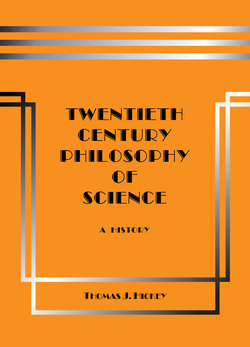Читать книгу Twentieth-Century Philosophy of Science: A History (Third Edition) - Thomas J. Hickey - Страница 107
На сайте Литреса книга снята с продажи.
4.27 Scientific Explanation
ОглавлениеA scientific explanation is a discourse consisting of a set of one or several related universally quantified law statements expressible jointly in a nontruth-functional hypothetical-conditional schema together with a particularly quantified antecedent description of realized initial conditions. Together these statements conclude by modus ponens deduction to a particularly quantified description of the consequent occurrence of the explained event.
Explanation is the ultimate aim of basic science. There are other types such as the historical explanation, but history is not a science, although it may use science, as in economic history. But only explanation in basic science is of interest in philosophy of science. When some course of action is taken in response to an explanation such as a social policy, a medical therapy or an engineered product or structure, the explanation is used as applied science. Applied science does not occasion a change in an explanation like basic science, unless there is a failure in spite of conscientious and competent implementation of the relevant laws.
The logical form of the explanation in basic science is the same as that of the empirical test. The universally quantified statements constituting a system of one or several related scientific laws in an explanation can be schematized as a nontruth-functional hypothetical-conditional statement in the logical form “For every A if A, then C”. But while the logical form is the same for both testing and explanation, the deductive argument is not the same.
The deductive argument of the explanation is the modus ponens argument instead of the modus tollens logic used for testing. In the modus tollens argument the hypothetical-conditional statement expressing the proposed theory is falsified, when the antecedent clause is true and the consequent clause is false. On the other hand in the modus ponens argument for explanation both the antecedent clause describing initial conditions and the hypothetical-conditional statement having law status are accepted as true, such that affirmation of the antecedent clause validly concludes to affirmation of the consequent clause describing the explained phenomenon.
Thus the schematic form of an explanation is “For every A if A, then C” is true. “A” is true. Therefore “C” is true (and explained). The conditional statement “For every A if A, then C” represents a set of one or several related universally quantified law statements applying to all instances of “A” and to all consequent instances of “C”. “A” is the set of one or several particularly quantified statements describing the realized initial conditions that cause the occurrence of the explained phenomenon as in a test. “C” is the set of one or several particularly quantified statements describing the explained individual consequent effect, which whenever possible is a prediction.
In the explanation the statements in the hypothetical-conditional schema express scientific laws accepted as true due to their empirical adequacy as demonstrated by nonfalsifying test outcomes. These together with the antecedent statements describing the initial conditions in the explanation constitute the explaining language some call the explanans. And they call the logically consequent language, which describes the explained consequent phenomenon, the explanandum.
It has also been said that theories “explain” laws. Neither untested nor falsified theories occur in a scientific explanation. Explanations consist of laws, which are formerly theories that have been tested with nonfalsifying outcomes. Proposed explanations are merely untested theories. Since all the universally quantified statements in the nontruth-functional hypothetical-conditional schema of an explanation are laws, the “explaining” of laws means that a system of logically related laws forms a deductive system partitioned into dichotomous subsets of explaining antecedent axioms and explained consequent theorems.
But in a formal axiomatic system the choice of axioms is arbitrary, so long as the chosen axioms are independent, i.e., no one of them can be derived deductively as theorems in the system from any of the other chosen axioms. And this arbitrariness permits the choice of axioms to be changed, such that what were originally theorems can be deemed axioms, and the original axioms can then be derived as theorems from the new axioms.
In his Patterns of Discovery Norwood Russell Hanson examines this feature in the case of Newton’s dynamical law statements. Hanson says that a statement may be deemed an empirical generalization, which can be explained by derivation as a theorem. Or it may be deemed a definitional statement or what Hanson calls a “functionally a priori” statement having no need of explanation and thus having axiomatic status. Thus it is always ambiguous as to just what statements are explaining and what statements are explained in any axiomatic system. Hanson says that microphysics has been misrepresented by philosophers who study the logic of the deductive systems. He says that their error is to regard as paradigms of scientific inquiry not unsettled, dynamic, research sciences like microphysics, but instead finished systems like planetary mechanics. Elsewhere in his literary corpus he ridicules them as “axiomitizers”.
Integrating laws into axiomatic systems confers psychological satisfaction by contributing semantical coherence. Influenced by some renderings of Newton’s physics many positivists had believed that producing reductionist axiomatic systems is part of the aim of science. But the reductionist preconception is not validated by the history of science. Great developmental episodes in the history of science have had the opposite effect, namely of fragmenting science. And while the fragmentation has occasioned the communication constraint and consequently opposition to the new discoveries, it has only delayed but has not halted the advancement of science in its history. Eventually pragmatic empiricism prevails.
